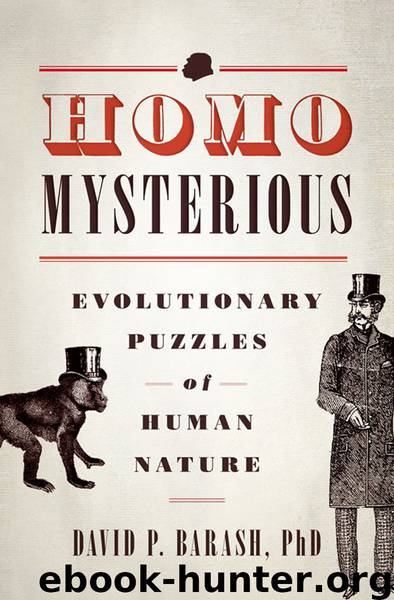Homo Mysterious by Barash David P

Author:Barash, David P.
Language: eng
Format: epub
Publisher: Oxford University Press, USA
Published: 2012-06-30T16:00:00+00:00
Gossip and “Theory of Mind”
Turning now from the visual to the narrative arts, another practical teaching payoff may derive from its role as a vehicle for sharing social information, which is to say, a classy form of gossip. Evolutionary anthropologist Robin Dunbar has made the intriguing suggestion that one of the keys to sociality—especially among primates (which includes Homo sapiens)—is social grooming, which includes the iconic inclination of monkeys and apes to sit around and pick ectoparasites off their best friends. Dunbar points out that as proto-hominid group size increased, it became increasingly difficult to maintain cohesion via direct physical contact, at which time verbal communication—gossip—may well have replaced grooming.5
Insofar as he is correct, it isn’t a huge step from gossip as grooming to stories as gossip. Indeed, much of the pleasure and delight modern readers derive from fiction may be very similar to what is gained from reading autobiographies, biographies, history, memoirs, and so forth, and which in turn differ only slightly from the payoff that comes from watching soap operas, reading confessional magazines, or sharing the latest news on friends, family, neighbors, and celebrities.
Gossip needn’t have the negative connotation it is typically accorded. It doesn’t have to be frivolous. After all, it has long been in our interest—highly social species that we are—to keep tabs on who’s doing what, who’s up and who’s down, what’s the latest dish on so-and-so or such-and-such. And stories provide a fine way of doing this, while also adding a dose of social glue.
In addition, fiction isn’t altogether untrue. Mark Twain once quipped that the difference between fiction and nonfiction is that the former must be “more real.” To be valued, a story must convey accurate truths about human nature: how people respond—and hence, how they can be expected to respond—under particular circumstances. Stories always incorporate insights into the behavior, and often the underlying mental processes, of other people. As such, they may well be useful in conveying information about what psychologists call Theory of Mind, which refers to the capacity of human beings to put themselves inside the heads of someone else, so as to anticipate their perceptions and behavior more accurately. There is much debate among specialists as to whether animals other than Homo sapiens possess an accurate Theory of Mind, but no doubt people do, just as there is no doubt that such information can be biologically as well as socially adaptive.
Whether functional as play or gossip, as a primer in Theory of Mind, or as something entirely different, stories are always about people, or animals, or—rarely—things. Never are they purely concerned with abstract concepts. This seemingly obvious conclusion hides a potentially important truth: the importance of stories as providing useful inroads into the lives of other people, animals, or things. For a lively example, consider this selection from Sylvie and Bruno Concluded, written by Lewis Carroll and published in 1893; it was the last novel written by the creator of the Alice books.iii At one point, a little girl
Download
This site does not store any files on its server. We only index and link to content provided by other sites. Please contact the content providers to delete copyright contents if any and email us, we'll remove relevant links or contents immediately.
The Art of Thinking Clearly by Rolf Dobelli(10214)
The 5 Love Languages: The Secret to Love That Lasts by Gary Chapman(9588)
Mindhunter: Inside the FBI's Elite Serial Crime Unit by John E. Douglas & Mark Olshaker(9187)
Becoming Supernatural by Dr. Joe Dispenza(8119)
Nudge - Improving Decisions about Health, Wealth, and Happiness by Thaler Sunstein(7615)
The Road Less Traveled by M. Scott Peck(7522)
Enlightenment Now: The Case for Reason, Science, Humanism, and Progress by Steven Pinker(7228)
Mastermind: How to Think Like Sherlock Holmes by Maria Konnikova(7223)
Win Bigly by Scott Adams(7094)
The Way of Zen by Alan W. Watts(6504)
Factfulness: Ten Reasons We're Wrong About the World – and Why Things Are Better Than You Think by Hans Rosling(4693)
The State of Affairs by Esther Perel(4637)
Gerald's Game by Stephen King(4571)
Man's Search for Meaning by Viktor Frankl(4420)
The Confidence Code by Katty Kay(4187)
Thinking in Bets by Annie Duke(4152)
The Healing Self by Deepak Chopra(3473)
Hidden Persuasion: 33 psychological influence techniques in advertising by Marc Andrews & Matthijs van Leeuwen & Rick van Baaren(3472)
The Worm at the Core by Sheldon Solomon(3432)
